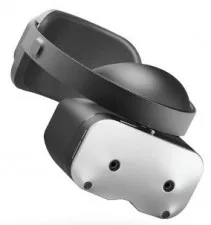Lynx (Paris, France) is about ready to ship the company’s redesigned headset, the Lynx R1. Configured for mixed reality, the headset can present in either virtual or augmented reality. The headset is stand-alone meaning that neither a wired nor a wireless connection to an external computer system is required for headset operation.

Perhaps a good way to start this article is to offer a few top level comments on the current state of affairs regarding headsets.
Stand-alone virtual reality headsets are available that include positional tracking. It is currently uncommon for this type of headset to be designed for mixed reality operation.
Mixed reality headsets are available but, at this time, these are not typically stand-alone.
Two types of augmented reality headsets are currently available. The first type is called see-through. In this type of headset, the user directly views the real world by looking through an optical combiner. The function of the combiner is to superimpose virtual imagery onto the user’s view of the real world. Given the current generation of see-through optics technology, the field of view is typically narrower than desired and the virtual imagery cannot be made fully opaque. The second type of augmented reality headset is called pass-through. This type of headset presents the real world to the viewer on a display with the image having been captured by cameras. The Lynx-R1 falls into the pass-through category.
The advantages of the approach used in the Lynx-R1 include a wider field of view, the capability to produce opaque virtual imagery and the potential for a headset that has a lower cost. The downside of the approach used in the Lynx-R1 is that the quality of the real world view may not be as good as that provided by a conventional, direct view augmented reality headset.
The Lynx-R1 headset is built around an optical module. The components in the optical module are discussed below.
Two high definition RGB cameras are installed on the front of the module. They serve to capture imagery of the real world for operation in the mixed reality mode and for gesture recognition. The video feed from these cameras is streamed in real time to the displays where it can be integrated with augmented reality video imagery. The latency of the system is reported to be in the range of from 12 to 18 milliseconds.
The Lynx-R1 does not include controllers. Rather, the headset includes two black and white cameras used for positional tracking. The primary mode of input to the system is tracking both of the user’s hands coupled with gesture recognition. The hardware to do this was developed by Lynx. The hand tracking software was provided by Ultraleap with The Finch Company providing controller compatibility. The headset is capable of 6 DoF inside-out SLAM tracking and utilizes world anchors. The headset is reported as compatible with 3 DoF and 6 DoF controllers offered by third parties.
Two IR cameras located on the inside of the headset are used for eye tracking.
The two displays in the headset are supplied by JDI. Each display has a resolution of 1600 x 1600 pixels and operates at a frame rate of 90 Hz.
The optical system in the module includes what is described as a 4 fold catadioptric freeform prism. This approach to optical system design is reported to allow for an extremely slim optical module and produces a 90 degree circular field of view.
Some of the other features and specification of the Lynx-R1 include the following:
- The displays are powered by a Qualcomm Snapdragon XR2 chip.
- The battery has a capacity of 8600 mAh. The battery is built into the back of the head mount and can provide power for 2 to 4 hours of intensive headset usage.
- Two noise canceling microphones are built in and can be used for communication, voice command and speech to text applications.
- Two stereo spatial audio speakers are integrated in the headband.
- Memory 6 GB
- Storage 128 GB
- Remote rendering using WIFI 6 (802.11ax) or USB-C.
- The USB-C port can be used to add a 5G modem or an additional sensor.
- Bluetooth 5.0
- The headset includes an accelerometer, a gyroscope and a magnetometer.
- Thermal management is reported to include active cooling.
- The case of the Lynx-R1 headset can be folded.
When used in the virtual reality mode, a face cushion is added to the front of the module to shield the user’s eyes from the real world. The cushion does not block the cameras and is attached to module with magnets.
A video at the end of this article discussed the Lynx-R1 headset. The figure below illustrates the Lynx-R1 headset with virtual reality face shield in place.
 The Lynx-R1 headset with the virtual reality face cushion in place.
The Lynx-R1 headset with the virtual reality face cushion in place.
The company has an open sensor policy. This means that raw data from every sensor is available to developers including data from the RGB cameras, eye tracking and hand gestures.
The operating system is Android 10. Support for OpenXR is in the planning stage. Lynx is currently working on the delivery of an Open Source launcher for virtual and augmented reality, sample apps and controller compatibility. The company stated that it will publish the source code for the launcher and the sample apps on its website.
The headset is currently priced at $1,500. Lynx has stated that the price could come down if the company is successful in on-going negotiations with its suppliers to reduce production costs.
The first group of redesigned Lynx-R1 headsets is scheduled to ship to regular customers sometime during December. -Arthur Berman

